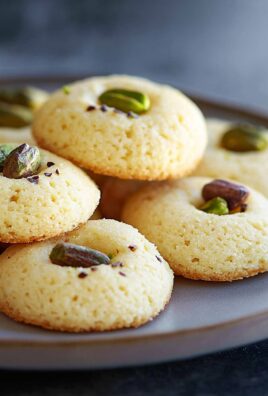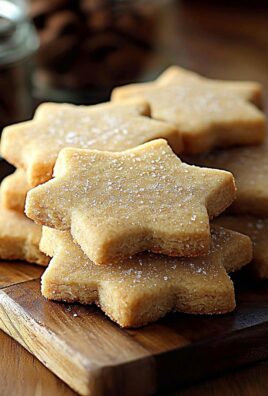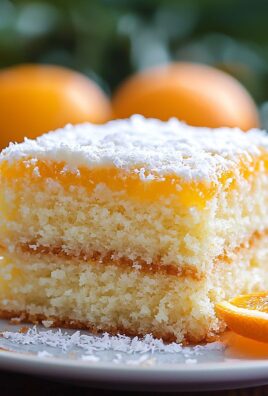Turkish Baklava: just the name conjures images of golden, flaky layers dripping with sweet, honeyed syrup. Have you ever experienced that moment of pure bliss when the delicate pastry shatters in your mouth, releasing a symphony of nutty and sweet flavors? If not, you’re in for a treat! This iconic dessert isn’t just a sweet indulgence; it’s a journey through centuries of culinary tradition.
Baklava’s history is a rich tapestry woven through the Ottoman Empire, with roots stretching back to ancient Assyria. While its exact origins are debated, there’s no denying that Turkish Baklava, as we know it today, was perfected in the kitchens of Topkapi Palace. Imagine the Sultan and his court savoring this exquisite treat, a symbol of wealth and refinement.
What makes baklava so irresistible? It’s the perfect balance of textures: the crisp, paper-thin layers of phyllo dough, the satisfying crunch of pistachios or walnuts, and the luscious, sticky syrup that binds it all together. Beyond its delightful texture, the taste is simply divine. The combination of buttery pastry, fragrant nuts, and sweet honey creates an unforgettable experience. Plus, while it might seem intimidating to make, with the right guidance, you can create this masterpiece in your own kitchen. So, let’s embark on this delicious adventure together and unlock the secrets to making authentic Turkish Baklava!
Ingredients:
- For the Dough:
- 500g (about 4 cups) all-purpose flour, plus extra for dusting
- 1 teaspoon salt
- 2 large eggs
- 1 cup (240ml) lukewarm milk
- 1/2 cup (120ml) vegetable oil
- 1 tablespoon white vinegar
- 250g (about 1 cup) cornstarch, for layering
- For the Filling:
- 500g (about 4 cups) finely ground walnuts or pistachios (or a mix)
- 1 teaspoon ground cinnamon (optional)
- For the Syrup:
- 2 cups (400g) granulated sugar
- 1 cup (240ml) water
- 1/4 cup (60ml) honey
- 1 tablespoon lemon juice
- 1/2 teaspoon vanilla extract (optional)
- For Brushing:
- 250g (about 1 cup) unsalted butter, melted
Preparing the Dough:
- In a large bowl, whisk together the flour and salt. This ensures the salt is evenly distributed throughout the dough.
- In a separate bowl, whisk together the eggs, lukewarm milk, vegetable oil, and white vinegar. The vinegar helps to tenderize the dough, resulting in a flakier baklava.
- Gradually add the wet ingredients to the dry ingredients, mixing with a wooden spoon or your hands until a shaggy dough forms.
- Turn the dough out onto a lightly floured surface and knead for about 5-7 minutes, or until the dough is smooth and elastic. It should be firm but pliable. If the dough is too sticky, add a little more flour, one tablespoon at a time.
- Divide the dough into 20-24 equal pieces. This is crucial for creating the thin layers that are characteristic of baklava. I find using a kitchen scale helps ensure even portions.
- Shape each piece into a small ball. Place the dough balls on a lightly floured baking sheet, cover with a damp cloth or plastic wrap, and let them rest for at least 1 hour, or preferably 2 hours. This resting period allows the gluten to relax, making the dough easier to roll out.
Preparing the Filling:
- In a medium bowl, combine the finely ground walnuts or pistachios (or a mix) with the ground cinnamon (if using). Mix well to ensure the cinnamon is evenly distributed. The cinnamon adds a warm, aromatic flavor to the baklava.
- Set the filling aside until ready to use.
Rolling Out the Dough:
- This is the most time-consuming but also the most important step! Lightly flour your work surface with cornstarch. Cornstarch is key to preventing the dough from sticking and helps create those paper-thin layers.
- Take one dough ball and flatten it slightly with your hand.
- Using a rolling pin, roll out the dough into a very thin circle, about 10-12 inches in diameter. The thinner the better! You should almost be able to see through the dough. Don’t worry if it tears a little; it will be layered.
- Dust the rolled-out dough generously with cornstarch. This prevents the layers from sticking together during baking.
- Repeat steps 2-4 with the remaining dough balls, stacking the rolled-out dough layers on top of each other, dusting each layer generously with cornstarch.
- Once all the dough balls have been rolled out and stacked, carefully transfer the stack to a large, clean work surface.
- Using a large rolling pin or an oklava (a long, thin rolling pin specifically designed for baklava), gently roll out the entire stack of dough into a large, thin sheet that is slightly larger than your baking pan. This requires patience and a gentle touch. The goal is to create a single, large sheet of paper-thin dough.
Assembling the Baklava:
- Preheat your oven to 350°F (175°C).
- Grease a 9×13 inch baking pan with melted butter.
- Carefully lift the rolled-out dough sheet and place it into the prepared baking pan. Gently press it into the corners and trim any excess dough that hangs over the edges.
- Melt the butter in a small saucepan or in the microwave. Make sure it’s completely melted and clear.
- Brush the top layer of dough generously with melted butter.
- Sprinkle half of the nut mixture evenly over the buttered dough.
- Carefully fold the overhanging edges of the dough inward to create a neat border.
- Brush the top of the nut mixture with more melted butter.
- Sprinkle the remaining nut mixture evenly over the buttered dough.
- Brush the top of the nut mixture with the remaining melted butter.
- Using a sharp knife or pizza cutter, cut the baklava into diamond or square shapes. Cut all the way through the layers of dough and nuts. This step is important for allowing the syrup to penetrate the baklava properly.
Baking the Baklava:
- Bake in the preheated oven for 45-60 minutes, or until the baklava is golden brown and crispy. The baking time may vary depending on your oven, so keep a close eye on it.
- While the baklava is baking, prepare the syrup.
Preparing the Syrup:
- In a medium saucepan, combine the sugar, water, and honey.
- Bring the mixture to a boil over medium heat, stirring constantly until the sugar is dissolved.
- Reduce the heat to low and simmer for about 15-20 minutes, or until the syrup has thickened slightly.
- Remove the saucepan from the heat and stir in the lemon juice and vanilla extract (if using). The lemon juice helps to prevent the syrup from crystallizing.
- Let the syrup cool slightly.
Soaking and Cooling:
- Once the baklava is baked, remove it from the oven and immediately pour the warm syrup evenly over the hot baklava. The contrast in temperature helps the baklava absorb the syrup properly.
- Let the baklava cool completely in the pan, at least 4-6 hours, or preferably overnight. This allows the baklava to fully absorb the syrup and develop its characteristic sweetness and stickiness.
- Once the baklava is completely cooled, cut along the pre-cut lines and serve.
Enjoy your homemade Turkish Baklava! It’s a labor of love, but the results are well worth the effort. Store any leftover baklava in an airtight container at room temperature for up to a week. It actually tastes even better the next day!

Conclusion:
This isn’t just another dessert recipe; it’s an invitation to experience a taste of history and culture, all within the confines of your own kitchen. I truly believe this Turkish Baklava recipe is a must-try for anyone who appreciates the art of baking and the joy of sharing something truly special. The layers of flaky phyllo, the rich nut filling, and the sweet, fragrant syrup combine to create a symphony of textures and flavors that will leave you and your loved ones utterly captivated.
Why is it a must-try? Because it’s more than just a sweet treat. It’s a project, a labor of love, and a testament to the power of simple ingredients transformed into something extraordinary. The satisfaction you’ll feel after carefully crafting each layer, patiently baking it to golden perfection, and then drizzling it with that luscious syrup is unparalleled. It’s an experience that engages all your senses and leaves you with a profound sense of accomplishment. Plus, let’s be honest, who can resist the allure of perfectly crisp, honey-soaked baklava?
But the best part? It’s incredibly versatile! While the classic recipe is divine, there’s plenty of room for experimentation.
Serving Suggestions and Variations:
* Warm it up: Serve it slightly warmed with a scoop of vanilla ice cream or a dollop of whipped cream for an extra indulgent treat. The contrast between the warm, flaky baklava and the cold, creamy topping is simply heavenly.
* Spice it up: Add a pinch of cardamom or cinnamon to the nut filling for a warm, aromatic twist. A little bit of spice can really elevate the flavor profile and add a touch of exotic flair.
* Nutty variations: Feel free to experiment with different nuts! While walnuts and pistachios are traditional, you could also try using almonds, pecans, or even a combination of your favorites. Just be sure to adjust the chopping size accordingly.
* Citrus zest: Add a teaspoon of orange or lemon zest to the syrup for a bright, citrusy note that cuts through the sweetness. This is a great way to add a touch of freshness and complexity to the overall flavor.
* Chocolate drizzle: For the chocolate lovers out there, a drizzle of melted dark chocolate over the finished baklava is a decadent addition that’s sure to impress.
* Pairing perfection: Serve it with a strong cup of Turkish coffee or a glass of sweet dessert wine for the ultimate indulgence. The bitterness of the coffee or the sweetness of the wine will complement the baklava beautifully.
I know that making baklava might seem a little intimidating at first, but trust me, it’s totally worth the effort. Follow the recipe carefully, take your time, and don’t be afraid to get your hands dirty. The process itself is incredibly rewarding, and the end result is something you’ll be proud to share with your friends and family.
So, what are you waiting for? Gather your ingredients, preheat your oven, and get ready to embark on a culinary adventure. I’m confident that you’ll fall in love with this Turkish Baklava recipe just as much as I have.
And most importantly, I want to hear about your experience! Did you try any of the variations? Did you encounter any challenges? What did your friends and family think? Share your photos, comments, and stories in the comments section below. I can’t wait to see your creations and hear about your baklava-making journey! Happy baking!
Turkish Baklava: A Delicious Guide to the Authentic Dessert
Flaky, buttery layers of homemade dough filled with nuts and soaked in sweet syrup. This traditional Turkish Baklava is a labor of love, but the results are worth the effort!
Ingredients
- 500g (about 4 cups) all-purpose flour, plus extra for dusting
- 1 teaspoon salt
- 2 large eggs
- 1 cup (240ml) lukewarm milk
- 1/2 cup (120ml) vegetable oil
- 1 tablespoon white vinegar
- 250g (about 1 cup) cornstarch, for layering
- 500g (about 4 cups) finely ground walnuts or pistachios (or a mix)
- 1 teaspoon ground cinnamon (optional)
- 2 cups (400g) granulated sugar
- 1 cup (240ml) water
- 1/4 cup (60ml) honey
- 1 tablespoon lemon juice
- 1/2 teaspoon vanilla extract (optional)
- 250g (about 1 cup) unsalted butter, melted
Instructions
- In a large bowl, whisk together the flour and salt.
- In a separate bowl, whisk together the eggs, lukewarm milk, vegetable oil, and white vinegar.
- Gradually add the wet ingredients to the dry ingredients, mixing with a wooden spoon or your hands until a shaggy dough forms.
- Turn the dough out onto a lightly floured surface and knead for about 5-7 minutes, or until the dough is smooth and elastic. If the dough is too sticky, add a little more flour, one tablespoon at a time.
- Divide the dough into 20-24 equal pieces.
- Shape each piece into a small ball. Place the dough balls on a lightly floured baking sheet, cover with a damp cloth or plastic wrap, and let them rest for at least 1 hour, or preferably 2 hours.
- In a medium bowl, combine the finely ground walnuts or pistachios (or a mix) with the ground cinnamon (if using). Mix well.
- Set the filling aside until ready to use.
- Lightly flour your work surface with cornstarch.
- Take one dough ball and flatten it slightly with your hand.
- Using a rolling pin, roll out the dough into a very thin circle, about 10-12 inches in diameter.
- Dust the rolled-out dough generously with cornstarch.
- Repeat steps 2-4 with the remaining dough balls, stacking the rolled-out dough layers on top of each other, dusting each layer generously with cornstarch.
- Once all the dough balls have been rolled out and stacked, carefully transfer the stack to a large, clean work surface.
- Using a large rolling pin or an oklava, gently roll out the entire stack of dough into a large, thin sheet that is slightly larger than your baking pan.
- Preheat your oven to 350°F (175°C).
- Grease a 9×13 inch baking pan with melted butter.
- Carefully lift the rolled-out dough sheet and place it into the prepared baking pan. Gently press it into the corners and trim any excess dough that hangs over the edges.
- Brush the top layer of dough generously with melted butter.
- Sprinkle half of the nut mixture evenly over the buttered dough.
- Carefully fold the overhanging edges of the dough inward to create a neat border.
- Brush the top of the nut mixture with more melted butter.
- Sprinkle the remaining nut mixture evenly over the buttered dough.
- Brush the top of the nut mixture with the remaining melted butter.
- Using a sharp knife or pizza cutter, cut the baklava into diamond or square shapes. Cut all the way through the layers of dough and nuts.
- Bake in the preheated oven for 45-60 minutes, or until the baklava is golden brown and crispy.
- While the baklava is baking, prepare the syrup.
- In a medium saucepan, combine the sugar, water, and honey.
- Bring the mixture to a boil over medium heat, stirring constantly until the sugar is dissolved.
- Reduce the heat to low and simmer for about 15-20 minutes, or until the syrup has thickened slightly.
- Remove the saucepan from the heat and stir in the lemon juice and vanilla extract (if using).
- Let the syrup cool slightly.
- Once the baklava is baked, remove it from the oven and immediately pour the warm syrup evenly over the hot baklava.
- Let the baklava cool completely in the pan, at least 4-6 hours, or preferably overnight.
- Once the baklava is completely cooled, cut along the pre-cut lines and serve.
Notes
- Resting the dough is crucial for gluten relaxation, making it easier to roll out.
- Cornstarch is key to preventing the dough from sticking and helps create those paper-thin layers.
- The thinner you roll the dough, the better the baklava will be.
- Cutting the baklava before baking allows the syrup to penetrate properly.
- The contrast in temperature between the hot baklava and warm syrup helps absorption.
- Baklava tastes even better the next day!
- Store any leftover baklava in an airtight container at room temperature for up to a week.





Leave a Comment